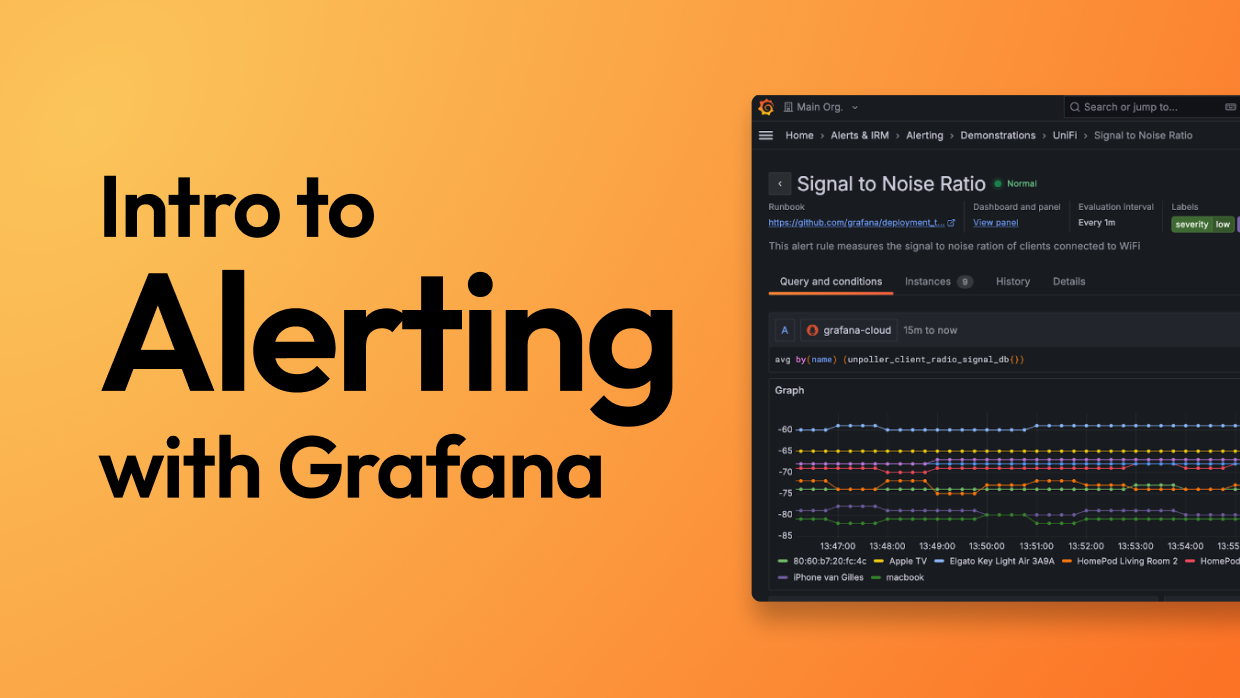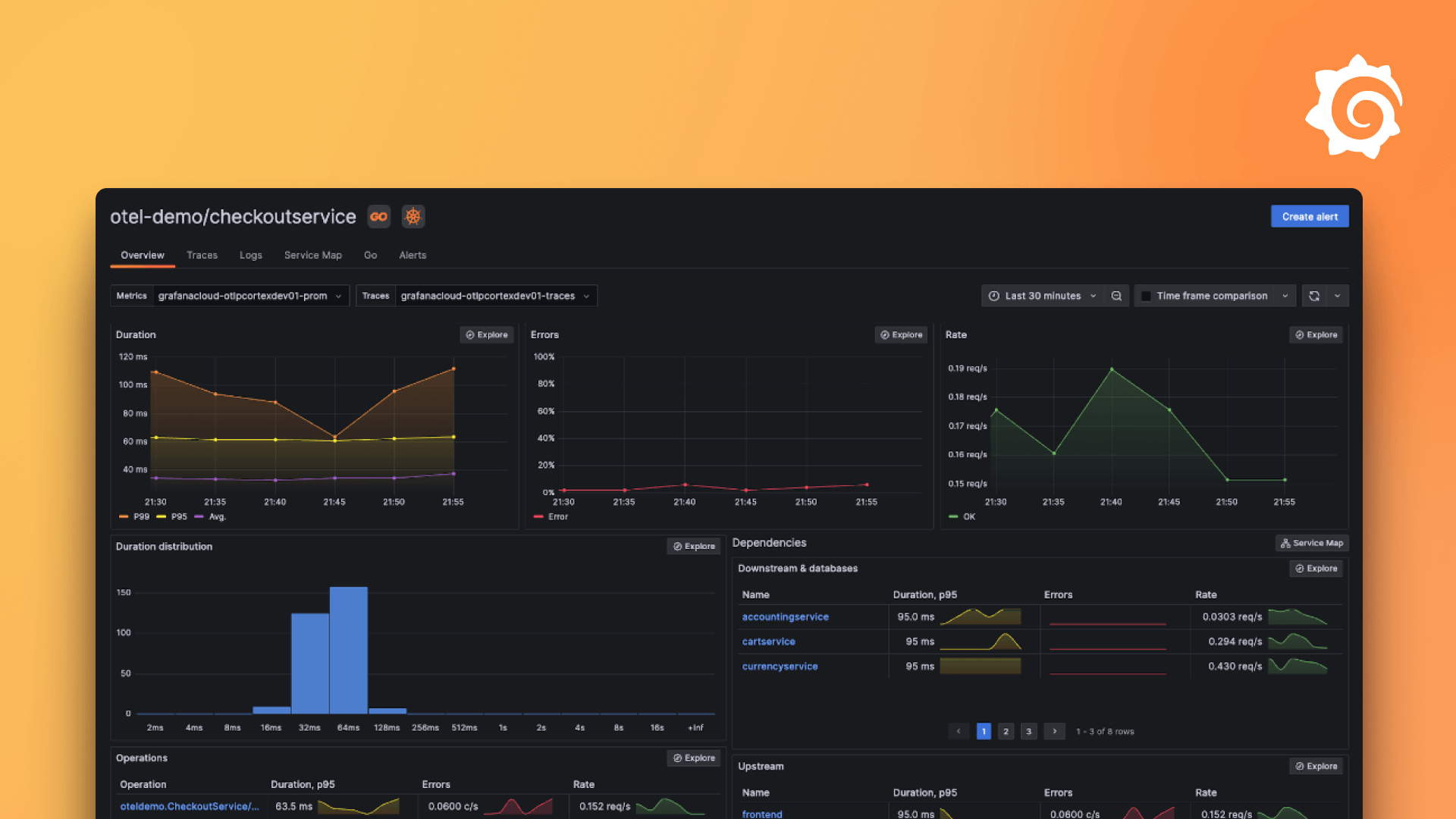Plugins 〉Tree View
Tree View
Grafana Tree Panel Plugin
This panel plugin shows a tree from records, provided by a datasource. The plugin is optized and tested with JSON API datasource.
This plugin presents JSON API responses, for example Kubernetes resources received from Kubernetes API. A possible production environment is described at https://github.com/pgillich/grafana-kubernetes.
Example screenshot about a Kubernetes Namespace:

Screenshot about a panel editor:

Datasource
All values from datasource are converted to string. The object type is converted to JSON string. The best datasource is JSON API, but other datasources may also be used, for example TestData Logs:

The number of values in fields must be same, so missing values must be substituted. JSON API supports JSONata, so it's possible.
Example JSONata expression for Kubernetes API, which substitutes the missing values (appName, containerState) and generates string about lists (containerImage, containerState):
$map(items, function($v) {{"namespace": $v.metadata.namespace, "name": $v.metadata.name, "appName": $v.metadata.labels."app.kubernetes.io/name" ? $v.metadata.labels."app.kubernetes.io/name" : ($v.metadata.labels."app" ? $v.metadata.labels."app" : "-"), "statusPhase": $v.status.phase, "containerCount": $count($v.spec.containers), "containerImage": $join($v.spec.containers[*].image, " "), "containerState": $v.status.containerStatuses[*].state ? $string($v.status.containerStatuses[*].state) : "-"}})
If Grafana runs outside of the Kubernetes cluster, a kubectl proxy command can create API endpoint for JSON API in order to access the cluster:
kubectl proxy --address 0.0.0.0 --accept-hosts='.*' --reject-methods=POST,PUT,PATCH -v5
It's highly recommended to use same JSONata expression in field definition, only the selected field should be different, for example:


Panel Options
Option descriptions can be read on the panel option editor:

The default template engine is a simple and fast ${field}-style expression processor, for example:
${statusPhase}
${namespace}
${appName} ${name}
${containerImage}
If a more complex template engine is needed, Handlebars can be used,
which is a {{field}}-style engine, for example:

Screenshot about a panel editor, with Handlebars engine:

Handlebars extensions
Pod info
An additional function is added to Handlebars, for having better information about Kubernetes Pods.
It's complex to evaluate the STATUS and other kubectl get pod -o wide columns from Kubernetes API responses,
so the printPod() function was ported to TypeScript. The syntax is: {{printPodColumn <whole_pod> "<column>"}}, where <whole_pod> the field, which contains the whole pod, <column> is the kubectl get pod -o wide column name, for example:
NAMEREADYSTATUSRESTARTSAGEIPNODENOMINATED_NODEREADINESS_GATESMESSAGE
The AGE behaves a little bit different: it's a little bit more precise.
The MESSAGE column contains additional info (reason) about the STATUS.
Example for printPodColumn:
{{printPodColumn rawPod "STATUS"}}
{{namespace}}
{{appName}} {{name}}
{{containerImage}} {{printPodColumn rawPod "MESSAGE"}}
Example JSONata datasource expression for above template:
$map(items, function($v) {{"rawPod": $v, "namespace": $v.metadata.namespace, "name": $v.metadata.name, "appName": $v.metadata.labels."app.kubernetes.io/name" ? $v.metadata.labels."app.kubernetes.io/name" : ($v.metadata.labels."app" ? $v.metadata.labels."app" : "-"), "statusPhase": $v.status.phase, "containerCount": $count($v.spec.containers), "containerImage": $join($v.spec.containers[*].image, " "), "containerState": $v.status.containerStatuses[*].state ? $string($v.status.containerStatuses[*].state) : "-"}})
Example screenshot for comparing Pod status info form raw Kubernetes API and from printPodColumn function:

Example Dashboards
Example dashboards can be found in examples.
Namespace Pods.jsonPods of a selected Namespace, Simple template engineAll Pods.jsonPods of all Namespaces, Handlebars template engine withkubectlcolumns.
Creating Issues
Please attach sample json file(s) to the new Issue.
Contributing
See more details in CONTRIBUTING.md.
Grafana Cloud Free
- Free tier: Limited to 3 users
- Paid plans: $55 / user / month above included usage
- Access to all Enterprise Plugins
- Fully managed service (not available to self-manage)
Self-hosted Grafana Enterprise
- Access to all Enterprise plugins
- All Grafana Enterprise features
- Self-manage on your own infrastructure
Grafana Cloud Free
- Free tier: Limited to 3 users
- Paid plans: $55 / user / month above included usage
- Access to all Enterprise Plugins
- Fully managed service (not available to self-manage)
Self-hosted Grafana Enterprise
- Access to all Enterprise plugins
- All Grafana Enterprise features
- Self-manage on your own infrastructure
Grafana Cloud Free
- Free tier: Limited to 3 users
- Paid plans: $55 / user / month above included usage
- Access to all Enterprise Plugins
- Fully managed service (not available to self-manage)
Self-hosted Grafana Enterprise
- Access to all Enterprise plugins
- All Grafana Enterprise features
- Self-manage on your own infrastructure
Grafana Cloud Free
- Free tier: Limited to 3 users
- Paid plans: $55 / user / month above included usage
- Access to all Enterprise Plugins
- Fully managed service (not available to self-manage)
Self-hosted Grafana Enterprise
- Access to all Enterprise plugins
- All Grafana Enterprise features
- Self-manage on your own infrastructure
Grafana Cloud Free
- Free tier: Limited to 3 users
- Paid plans: $55 / user / month above included usage
- Access to all Enterprise Plugins
- Fully managed service (not available to self-manage)
Self-hosted Grafana Enterprise
- Access to all Enterprise plugins
- All Grafana Enterprise features
- Self-manage on your own infrastructure
Installing Tree View on Grafana Cloud:
Installing plugins on a Grafana Cloud instance is a one-click install; same with updates. Cool, right?
Note that it could take up to 1 minute to see the plugin show up in your Grafana.
Installing plugins on a Grafana Cloud instance is a one-click install; same with updates. Cool, right?
Note that it could take up to 1 minute to see the plugin show up in your Grafana.
Installing plugins on a Grafana Cloud instance is a one-click install; same with updates. Cool, right?
Note that it could take up to 1 minute to see the plugin show up in your Grafana.
Installing plugins on a Grafana Cloud instance is a one-click install; same with updates. Cool, right?
Note that it could take up to 1 minute to see the plugin show up in your Grafana.
Installing plugins on a Grafana Cloud instance is a one-click install; same with updates. Cool, right?
Note that it could take up to 1 minute to see the plugin show up in your Grafana.
Installing plugins on a Grafana Cloud instance is a one-click install; same with updates. Cool, right?
Note that it could take up to 1 minute to see the plugin show up in your Grafana.
Installing plugins on a Grafana Cloud instance is a one-click install; same with updates. Cool, right?
Note that it could take up to 1 minute to see the plugin show up in your Grafana.
For more information, visit the docs on plugin installation.
Installing on a local Grafana:
For local instances, plugins are installed and updated via a simple CLI command. Plugins are not updated automatically, however you will be notified when updates are available right within your Grafana.
1. Install the Panel
Use the grafana-cli tool to install Tree View from the commandline:
grafana-cli plugins install The plugin will be installed into your grafana plugins directory; the default is /var/lib/grafana/plugins. More information on the cli tool.
Alternatively, you can manually download the .zip file for your architecture below and unpack it into your grafana plugins directory.
Alternatively, you can manually download the .zip file and unpack it into your grafana plugins directory.
2. Add the Panel to a Dashboard
Installed panels are available immediately in the Dashboards section in your Grafana main menu, and can be added like any other core panel in Grafana.
To see a list of installed panels, click the Plugins item in the main menu. Both core panels and installed panels will appear.
Changelog
<!-- 0.1.9 START -->
0.1.9 (2022-06-)
Features and enhancements
Bug fixes
- Remove kubernetes/client-node dependency
- Handling empty and undefined JSON list
<!-- 0.1.9 END -->
<!-- 0.1.8 START -->
0.1.8 (2022-02-)
Features and enhancements
- Add Handlebars template engine.
- Add generated @kubernetes/client-node model to the source code
- Add
kubectl get pod -o wide-like column evaluating to Handlebars template engine.
Bug fixes
- Better handling empty JSON list
- Kubernetes developer info
<!-- 0.1.8 END -->
<!-- 0.1.7 START -->
0.1.7 (2022-05-26)
Features and enhancements
Signed plugin.
Bug fixes
<!-- 0.1.6 START -->
0.1.6 (2022-02-01)
The first version to send it to Grafana for jury.
Features and enhancements
Bug fixes
<!-- 0.1.6 END -->





